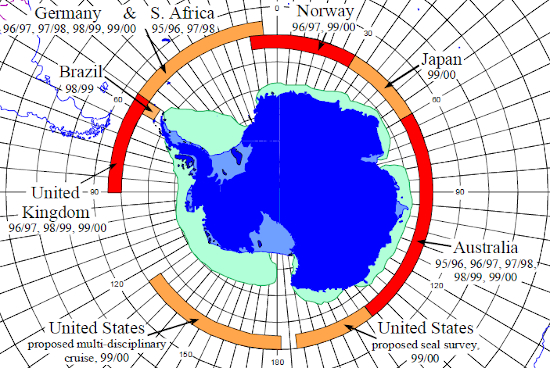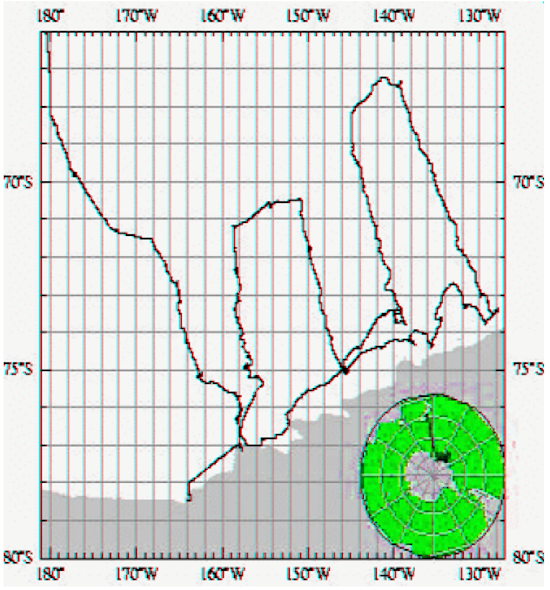Abstract
The pack ice region surrounding Antarctica contains at least 50% of the world’s population of seals, comprising about 80% of the world’s total pinniped biomass. The Antarctic Pack Ice Seal (APIS) Program was formulated to consider the functional significance of these upper trophic level predators (crabeater seals, Lobodon carcinophagus; Ross seals, Ommatophoca rossii; leopard seals, Hydrurga leptonyx; Weddell seals, Leptonychotes weddellii) and to assess the relative influences of biotic and abiotic features on their distribution, behavior, and physiology. Participating nations include Australia, Germany, Great Britain, Norway, South Africa, and the United States (Fig. 1). The APIS program presents a unique opportunity to evaluate the health status of a top-level predator with concurrent information on both host-specific and environment-specific factors. Nine science groups participated in the U.S. cruise (funded by the National Science Foundation) from 20 December 1999 to 10 February 2000 (Fig. 2). Environmental factors were addressed by those studying ecologic interactions among seals, their prey (fish, squid, zooplankton), and the physical environment (hydrography, sea ice). Other groups addressed host factors of nutritional status, genetic constitution (population genetics, immunogenetics) and behavior, and our project focused on health and disease of seals.
Figure 1

Participation of national Antarctic programs in the international APIS Program (years when research was conducted or is planned are indicated). In addition to the countries listed, Argentina, Belgium, Chile, and China are also in the process of seeking funding and ship or aircraft support for APIS research.
Figure 2

Actual track of the U.S. Antarctic Pack Ice Seal (APIS) research cruise, 20 December 1999 to 10 February 2000. Ship-based helicopter surveys covered over 15,000 km of trackline, including deep pack ice, polynya, and ice edge habitats. Biomedical samples were collected from 147 seals: 58 crabeater, 46 Weddell, 40 Ross, 3 leopard.
Biomedical samples were collected from 58 crabeater seals, 46 Weddell seals, 40 Ross seals and 3 leopard seals. Seals were physically restrained (Weddell seals, most Ross seals, some crabeater seals), lightly sedated (some Ross seals; 0.03–0.06 mg/kg diazepam) or chemically immobilized (most crabeater seals, all leopard seals; 2.5–2.8 mg/kg ketamine alone or combined with 0.7–1.1 mg/kg xylazine and/or 0.03–0.10 mg/kg diazepam). Seals were examined, measured and a representative sample was weighed. Blood and skin samples were collected from all seals; blubber samples, microbiologic swabs, fecal samples and urine samples were collected from a subset of seals. The timing of the cruise coincided with the post-breeding season molt for all species, and this was reflected in the most common lesions observed: bite wounds from conspecifics on adults, predator wounds on weaned pups, mild dermatopathies, subclinical inflammatory hemograms and chemistries. Preliminary microbiologic workups (85 bacteriologic swabs from 70 seals) were performed aboard ship (by Marilyn Koski, DVM), including Salmonella screens, gastrointestinal tract flora examinations, and skin and wound cultures. A general scan of fecal enteric bacteria revealed organisms commonly found in fish-eating mammals: Aeromonas sp., Vibrio sp., Pasteurella sp., Edwardsiella sp. Additional microbial analyses, Salmonella typing, and pathogen serology (e.g., morbillivirus, herpesvirus, Brucella, Leptospira) are pending.
Participants in the U.S. APIS program will meet to integrate their findings in late 2000 and 2001; an international APIS conference is planned for 2002.